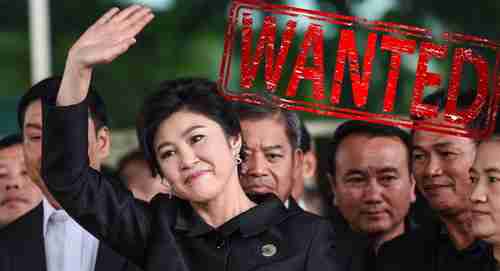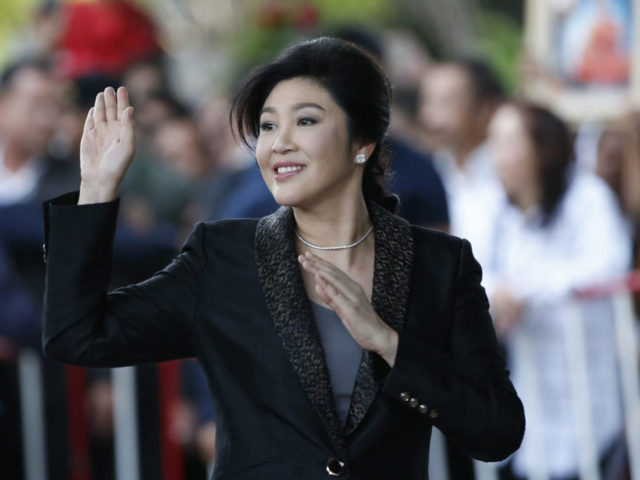This morning’s key headlines from GenerationalDynamics.com
- Thailand’s former prime minister Yingluck Shinawatra flees to Dubai
- Collapse of Thailand’s democracy
- Brief generational history of Thailand
Thailand’s former prime minister Yingluck Shinawatra flees to Dubai

Yingluck Shinawatra has fled Thailand to escape sentencing
Police in Bangkok, the capital city of Thailand, are searching for former Prime Minister Yingluck Shinawatra, for whom an arrest warrant was issued after she failed to show up for a sentencing hearing which might have put her in jail for decades. Her commerce minister, Boonsong Teriyapirom, did show up for sentencing, and was sentenced to 42 years in jail.
Yingluck became prime minister in 2011 after winning an election decisively, after a campaign in which she promised to use ‘femininity’ to resolve disputes.
However, she was ousted by a military coup in 2014. The ruling military junta then impeached her retroactively and froze her assets. She was then tried and convicted for improperly administering a rice subsidy program that mostly targeted the poor indigenous Thai-Thai people in northern Thailand.
She was to be sentenced on Friday, but she failed to show up in court and is now believed to have fled to somewhere abroad, such as Singapore, Hong Kong or Dubai. Her location has not been confirmed, but unnamed sources say that she has joined her brother in Dubai.
Her brother is former prime minister Thaksin Shinawatra, a telecommunications magnate turned politician who was ousted as prime minister in 2006 and fled the country in 2008 when he was convicted for conflict of interest. Since then, he’s been living in exile in Dubai and London.
Both Yingluck and Thaksin are extremely popular. The ruling military junta is being blamed for letting her escape, but there are suspicions that they purposely let her go, rather than risk massive protests if she were sent to jail. The Nation (Thailand) and Straits Times (Singapore) and CNN
Related Articles
- Thailand’s Yingluck Shinawatra wins decisively (04-Jul-2011)
- Thailand’s Yingluck promises to use ‘femininity’ to resolve disputes (01-Jul-2011)
- Thailand government collapses, ending crippling riots from class war (03-Dec-2008)
Collapse of Thailand’s democracy
Thailand adopted a constitution in 1997 that was supposed to guarantee that the country would be governed by free and fair democratic elections. Unfortunately for the country’s Thai-Chinese elite minority, the winners of the last five elections have all been candidates from the Pheu Thai political party, which represents the interests of the Thai-Thai indigenous population.
On the one side, you have the market-dominant “yellow shirt” light-skinned elites, also called “Thai-Chinese,” since almost all of them are descendants of Chinese, comprising about 1/4 of the population, living mostly around the capital city Bangkok.
On the other side, you have the “red shirt” dark-skinned lower class indigenous people, also called “Thai-Thai,” comprising about 3/4 of the population, living mostly in the northern and northeastern regions of Thailand, but who come to Bangkok mostly to work in menial jobs serving the Thai-Chinese.
Obviously, if elections are fought along ethnic lines, then the party representing the Thai-Thai is going to win every time. The yellow shirt elites have used a variety of techniques, from violent protests to army coups, to overturn these elections. The Thai-Thai hero Thaksin Shinawatra was prime minister until 2006, when an army coup forced him out of office. His sister Yingluck was forced out of office in 2014.
Incidentally, my favorite story in this saga occurred in December 2008. (“Thailand government collapses, ending crippling riots from class war”.) A candidate representing Thai-Thai, Samak Sundaravej, had been elected prime minister. After violent protests by the yellow shirts, he was forced to step down, because a court removed him from office because he had previously had a cooking show on tv, and that was somehow considered a conflict of interest. That is how ridiculous Thailand’s government has become.
So the ruling military junta is under pressure to allow new elections, but everybody knows that the Thai-Thai candidate, possibly even another member of the Shinawatra family, will win again. So the junta is amending the constitution to make sure that only the elite Thai-Chinese win elections. Bangkok Post
Brief generational history of Thailand
Part of Thailand’s history was made famous by Anna Leonowens, who came from London to Siam (as it was known then) to be the governess and teacher of the many children of King Mongkut (Rama IV) in the 1860s. In 1895, she wrote memoirs that were turned into a film, Anna and the King of Siam in 1946, and into the 1952 Rodgers and Hammerstein Broadway musical, “The King and I.”
If you have a few minutes, then watch the YouTube video of “The March of the Siamese Children,” from the 1956 film, The King and I. It depicts Anna’s first meeting with the children.
The play depicts a troubled king trying to lead a small country surrounded by large enemies, and willing to use invasion, torture and other atrocities.
King Rama had fought a generational crisis war in the early 1830s when he had invaded Laos and Cambodia, but ended up losing to a Vietnamese army.
Siam’s next generational crisis war occurred in what is now southern Thailand. For centuries, Siam’s kings had felt that the Muslims in southern Siam were a major threat to the security of the country, mainly because resistance and rebellion against Thai government rule were so strong among the Muslim population and, in fact, the southern Muslims had revolted during the 1830s crisis war.
By the late 1800s this threat had been felt to be critical, and in 1902 King Rama V invaded and annexed the Malay kingdom of Patani, consisting of the four provinces of Satun, Yala, Pattani, and Narathiwat. (Note: The kingdom is spelled “Patani,” while the province is spelled “Pattani.”) In 1909, an Anglo-Siamese Agreement established the present border between Thailand and Malaysia.
During the next few decades, Siam (which became Thailand in 1939) was faced with the problem of trying to assimilate the southern Muslim population into what is essentially a Buddhist country. During the generational Awakening era that followed, the military coup of 1932 overthrew the absolute monarchy in Siam and replaced it with constitutional monarchy. This was a representative form of government that promised a high degree of political participation of the Malay-Muslims in the South. However, as World War II (an Awakening era war for Thailand) approached, the country became more Thai-nationalistic, and the country adopted a policy of forced assimilation towards the Muslims, which had little success, as resistance and rebellion have continued since then.
The 1930s also saw a large influx of migrants from China, coming to the country to work. Over the decades, they were able to displace the indigenous people in positions of power in government, and in control of businesses. This formed an ethnic fault line between the indigenous Thai-Thai majority and the elite Thai-Chinese minority.
The next generational crisis war was the Cambodian “killing fields” war, 1975-79, in which Pol Pot’s communist Khmer Rouge government, backed by China, killed almost ten million people in a massive genocide. The Cambodian war spilled over into Thailand in the form of a communist rebellion that had begun in the 1960s. King Bhumibol (Rama IX) became an essential figure in the fight against the communists, although his role became more controversial in the savage anti-leftist coup of 1976, in which dozens of students were brutally killed by the security forces and royal-backed militias, and thousands forced to flee to seek sanctuary with the Communist Party.
The Cambodian “killing fields” civil war took place on Thailand’s doorstep, though not on Thai soil. Still, it caused a split along the Thai-Thai versus Thai-Chinese fault line that continues to the present time. Today, Thailand is in a new generational Awakening/Unraveling era, and we are seeing a repeat of what happened in the 1930s.
During the generational Awakening era of the 1930s, the military coup of 1932 overthrew the absolute monarchy in Siam and replaced it with constitutional monarchy that gave some power to the southern Muslims, only to have it taken away a few years later.
During the current era, the 1997 constitution guaranteed free elections for everyone, including the indigenous Thai-Thai, and now that’s being taken away by a military junta.
History doesn’t repeat itself, but it rhymes. Yale: Thailand’s Response to the Cambodian Genocide and Cornell: History and Politics of the Muslims in Thailand (PDF)
Related Articles
- Thailand mourns as Massachusetts-born King Bhumibol Adulyadej dies (14-Oct-2016)
- Thailand again in crisis as anti-government rioters issue two-day ultimatum (02-Dec-2013)
- Thailand’s army seizes power in major victory for ‘yellow shirt’ elites (23-May-2014)
KEYS: Generational Dynamics, Thailand, Yingluck Shinawatra, Boonsong Teriyapirom, Thai-Thai, red shirts, Thai-Chinese, yellow shirts, Thaksin Shinawatra, Samak Sundaravej, Anna Leonowens, Siam, King Mongkut, Rama IV, Anna and the King of Siam, Rodgers and Hammerstein, The King and I, Rama V, Malaysia, Kingdom of Patani, Satun, Yala, Pattani, Narathiwat, China, Laos, Vietnam, Cambodia, Killing fields, King Bhumibol, Rama IX
Permanent web link to this article
Receive daily World View columns by e-mail

COMMENTS
Please let us know if you're having issues with commenting.